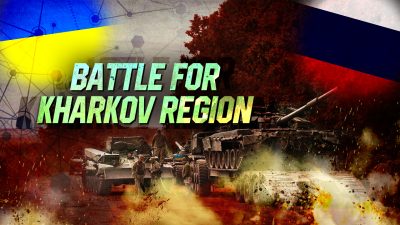Video: Battle for Kharkov Region: Has NATO Gained Advantage?

All Global Research articles can be read in 51 languages by activating the “Translate Website” drop down menu on the top banner of our home page (Desktop version).
To receive Global Research’s Daily Newsletter (selected articles), click here.
Visit and follow us on Instagram, Twitter and Facebook. Feel free to repost and share widely Global Research articles.
***
The offensive operation of the Armed Forces of Ukraine and NATO in the Kharkov region was planned by the US military command. About 200 units of heavy military vehicles and up to 9 thousand soldiers were involved in the offensive. Reportedly, every third soldier operating under the Ukrainian chevron was a citizen of a NATO member state. These forces were 4-5 times superior to the units of the DPR, LPR and Russia defending their positions in the region.
The main goal of the Ukrainian offensive was a flank attack, encirclement and subsequent destruction of the Russian grouping in the area of Balakleya, Kupyansk and Izyum.
The Russian command predicted the attack by large forces of Ukraine and NATO in this direction. It was aware that it would be extremely difficult to contain the enemy’s offensive with the forces that it had. It was also almost impossible to transfer timely sufficient reinforcement without weakening other areas on other front lines.
Assessing the risks, the Russian military decided to leave weakly fortified positions and withdraw troops to new lines and straighten communication lines.
Before the start of the Ukrainian offensive, civilians who agreed to move to the territory of the Russian Federation were evacuated from the threatened settlements.
From September 6 to 11, Russian units were withdrawing in an organized manner under the cover of specially organized units. Using mobile defense tactics, the Russian military destroyed the plan of Kiev and NATO to encircle the Russian grouping.
At the same time, there were obvious mistakes made by the Russian military. The area in front of the forward positions was not mined. Units on the front line de facto had no more than 30 percent of the listed military personnel. The soldiers were not properly provided with anti-tank weapons. There were also failures of the front-line intelligence. As a result, the artillery cover of the withdrawal was ineffective in the first days of the Ukrainian offensive.
Now on September 12, Russian troops have been withdrawn to new positions along the eastern bank of the Oskol River with minimal losses. Meanwhile, both sides confirm that the Ukrainian and NATO units suffered significant losses in manpower.
Almost the entire territory of the Kharkov region came under the control of Kiev with minimal damage to the cities’ infrastructure. Immediately after taking control of the settlements, the Ukrainian military began repressions against the pro-Russian population, violating the Geneva Convention relative to the Protection of Civilian Persons in Time of War. The first cases of the executions were already reported.
Large Russian reserves are being transferred to the battlefields. The strategically important settlement of Krasny Liman has not yet been taken by the Ukrainian military. The fighting continues.
Last night, missile strikes hit the largest electricity facilities in eastern Ukraine. The collapse of the power system affected networks in the Kharkiv, Sumy, Dnipropetrovsk, Zaporozhye, Odessa, Donetsk and Kiev regions. Until now, the power supply has not yet been fully restored.
The armed conflict in eastern Ukraine has finally turned into a state of war between Russia and NATO with unpredictable results for all parties in the conflict.
*
Note to readers: Please click the share buttons above or below. Follow us on Instagram and Twitter and subscribe to our Telegram Channel. Feel free to repost and share widely Global Research articles.
SUPPORT SOUTHFRONT:
PayPal: [email protected], http://southfront.org/donate/ or via: https://www.patreon.com/southfront
Featured image is from SF

